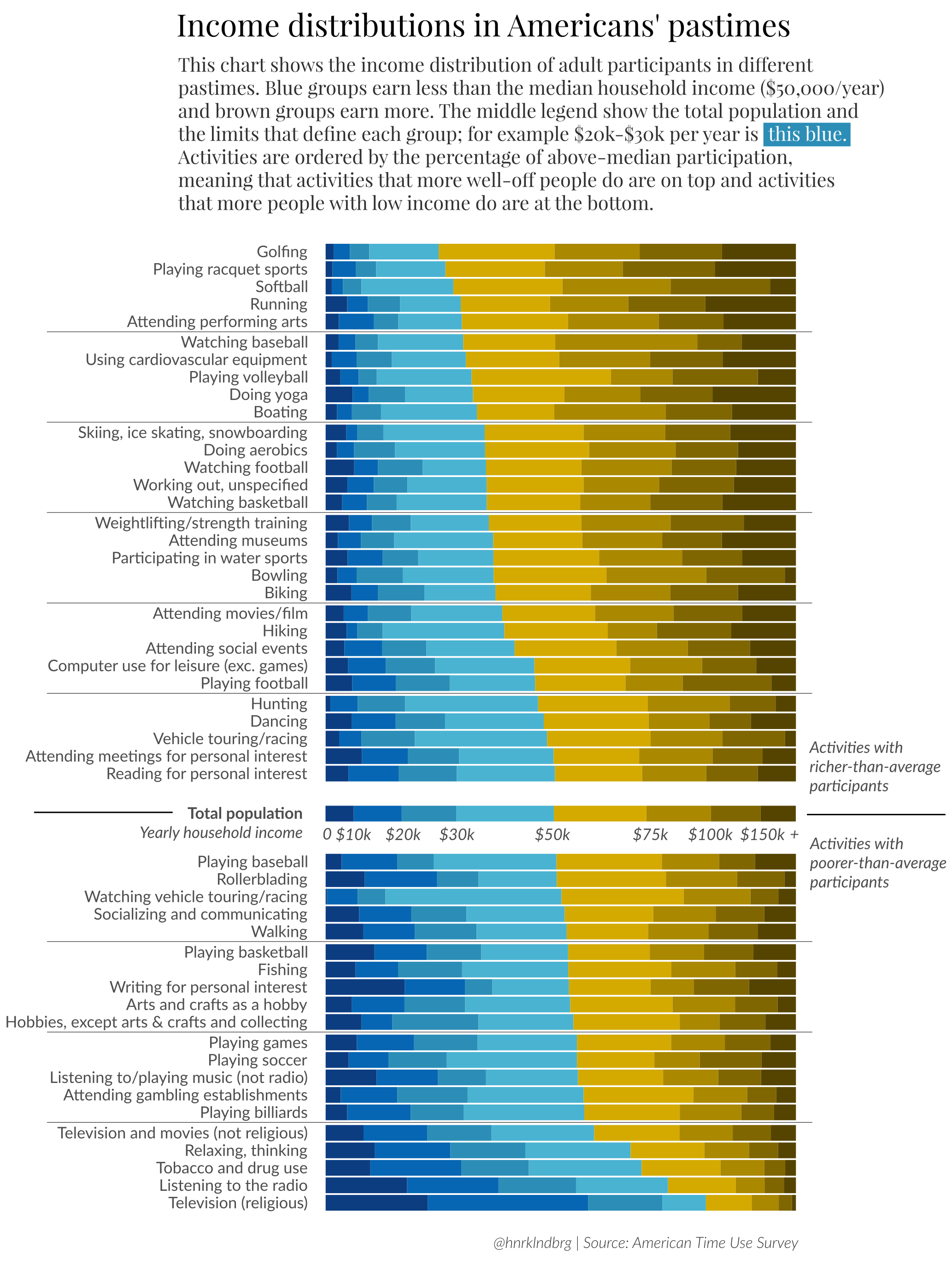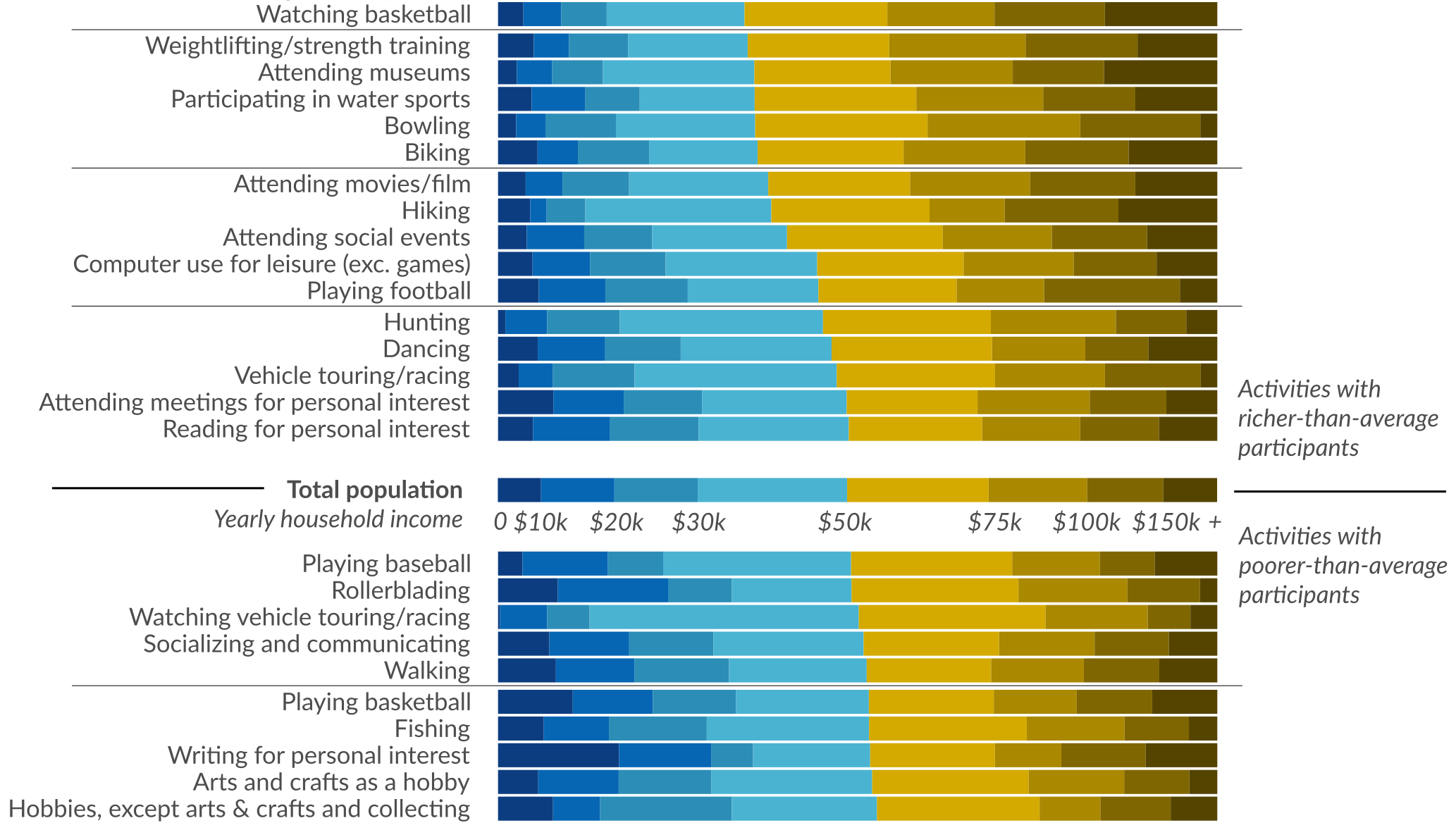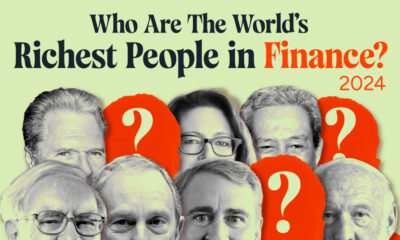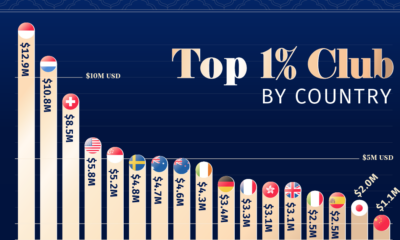Misc
Here’s How Americans Spend Their Time, Sorted by Income

Today’s visualization comes from data scientist Henrik Lindberg, and it shows America’s favorite past-times based on the participation of people in different income brackets.
It uses data from the American Time Use Survey that is produced by the Bureau of Labor Statistics (BLS) to break down these activities.
Common Interests
While activities are all over the map, it appears that some past-times are more common across all income groups.
Team sports and solo pursuits both are represented well in the center. In fact, reading for personal interest, dancing, computer use, hunting, hiking, walking, playing basketball, or playing baseball can all be found in the middle of the spectrum, appealing to Americans in every income group.
Closer to the top and bottom of the visualization, however, we see where income groups diverge in how they spend their time. It’s probably not surprising to see that people with higher incomes spend more time golfing, playing racket sports, attending performing arts, and doing yoga than average. On the flipside, lower income Americans spend more time watching television, listening to the radio, and listening to/playing music.
Curious Anomalies
Every data set has its own peculiarities. Sometimes these things can be explained, and sometimes they are just aberrations created as a result of how data was collected (i.e. how a survey was worded, bias, or some other error).
Here are some of the stranger anomalies that appear in this data set. We won’t attempt to explain them here, but feel free to speculate in the comments section:
- Higher income Americans disproportionately enjoy softball – while baseball has more universal appeal across income groups.
- While activities like boating are typically associated with higher income levels, the activity of running is generally not. Yet, running is disproportionately enjoyed by higher income Americans, according to this survey.
- Despite playing baseball being fairly universal across the spectrum, watching baseball skews higher income.
- Writing for personal interest has an interesting distribution: it is enjoyed disproportionately by poorer and richer Americans, but is underrepresented in the middle class.
Can you find anything else that stands out as being an anomaly?
VC+
VC+: Get Our Key Takeaways From the IMF’s World Economic Outlook
A sneak preview of the exclusive VC+ Special Dispatch—your shortcut to understanding IMF’s World Economic Outlook report.

Have you read IMF’s latest World Economic Outlook yet? At a daunting 202 pages, we don’t blame you if it’s still on your to-do list.
But don’t worry, you don’t need to read the whole April release, because we’ve already done the hard work for you.
To save you time and effort, the Visual Capitalist team has compiled a visual analysis of everything you need to know from the report—and our upcoming VC+ Special Dispatch will be available exclusively to VC+ members on Thursday, April 25th.
If you’re not already subscribed to VC+, make sure you sign up now to receive the full analysis of the IMF report, and more (we release similar deep dives every week).
For now, here’s what VC+ members can expect to receive.
Your Shortcut to Understanding IMF’s World Economic Outlook
With long and short-term growth prospects declining for many countries around the world, this Special Dispatch offers a visual analysis of the key figures and takeaways from the IMF’s report including:
- The global decline in economic growth forecasts
- Real GDP growth and inflation forecasts for major nations in 2024
- When interest rate cuts will happen and interest rate forecasts
- How debt-to-GDP ratios have changed since 2000
- And much more!
Get the Full Breakdown in the Next VC+ Special Dispatch
VC+ members will receive the full Special Dispatch on Thursday, April 25th.
Make sure you join VC+ now to receive exclusive charts and the full analysis of key takeaways from IMF’s World Economic Outlook.
Don’t miss out. Become a VC+ member today.
What You Get When You Become a VC+ Member
VC+ is Visual Capitalist’s premium subscription. As a member, you’ll get the following:
- Special Dispatches: Deep dive visual briefings on crucial reports and global trends
- Markets This Month: A snappy summary of the state of the markets and what to look out for
- The Trendline: Weekly curation of the best visualizations from across the globe
- Global Forecast Series: Our flagship annual report that covers everything you need to know related to the economy, markets, geopolitics, and the latest tech trends
- VC+ Archive: Hundreds of previously released VC+ briefings and reports that you’ve been missing out on, all in one dedicated hub
You can get all of the above, and more, by joining VC+ today.
-

 Markets1 week ago
Markets1 week agoU.S. Debt Interest Payments Reach $1 Trillion
-

 Markets2 weeks ago
Markets2 weeks agoRanked: The Most Valuable Housing Markets in America
-

 Money2 weeks ago
Money2 weeks agoWhich States Have the Highest Minimum Wage in America?
-

 AI2 weeks ago
AI2 weeks agoRanked: Semiconductor Companies by Industry Revenue Share
-

 Markets2 weeks ago
Markets2 weeks agoRanked: The World’s Top Flight Routes, by Revenue
-

 Countries2 weeks ago
Countries2 weeks agoPopulation Projections: The World’s 6 Largest Countries in 2075
-

 Markets2 weeks ago
Markets2 weeks agoThe Top 10 States by Real GDP Growth in 2023
-

 Money2 weeks ago
Money2 weeks agoThe Smallest Gender Wage Gaps in OECD Countries













